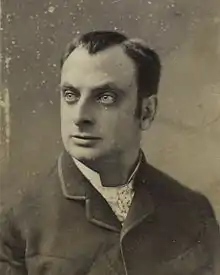Neil Burgess
Neil Burgess (1846, Boston, Massachusetts – 1910) was an American Vaudevillian comedian who specialized in female impersonation of elderly "widders".
Neil Burgess | |
|---|---|
 | |
| Born | 1846 Boston, Massachusetts |
| Died | 1910 |
| Occupation | Vaudeville comedian |
Biography
He started his unusual career at age 19 when called on to fill in for an ailing actress in The Quiet Family in Providence, Rhode Island.
Burgess debuted in New York as a solo artist in 1872 under produce Tony Pastor, when he was billed as an "Ethiopian Comedian".[1] His first role as a female impersonator came in 1877 in The Coming Woman for the Theatre Comique of Edward Harrigan and Tony Hart.[1] He was soon recognized as one of the leading female impersonators, successively playing women's parts in vaudeville. By the 1880s, he took several such roles in The Widow and the Elder, Betsey Bobbet: A Drama (later renamed Vim), and the County Fair.[2] His greatest success was Widow Bedott in 1879. He also produced and starred as Auntie Abigail Prue in Charles Barnard's play The County Fair in 1889. George C. Odell later reflected on these roles: "I still see him as Widow Bedott in the kitchen, making pies, straightening out the affairs of the neighborhood and personifying, in spite of his sex, the attribuates of a managing woman. He was not the least bit effeminate, not at all like the usual female impersonator of minstrelsy or of variety, and yet he was Widow Bedott to the life, and with little suggestion of burlesque."[3]
Burgess was also interested in inventions tied to the stage and backed a turntable device that allowed horses to run at full speed on stage, and another device that simulated the sound of a large crowd.
References
| Wikimedia Commons has media related to Neil Burgess. |
- Bordman, Gerald and Thomas S. Hischak. The Oxford Companion to American Theatre. New York: Oxford University Press, 2004: 221. ISBN 0-19-516986-7
- Morris, Linda A. Gender Play in Mark Twain: Cross-Dressing and Transgression. Columbia: University of Missouri Press, 2007: 5
- Morris, Linda A. Gender Play in Mark Twain: Cross-Dressing and Transgression. Columbia: University of Missouri Press, 2007: 5–6